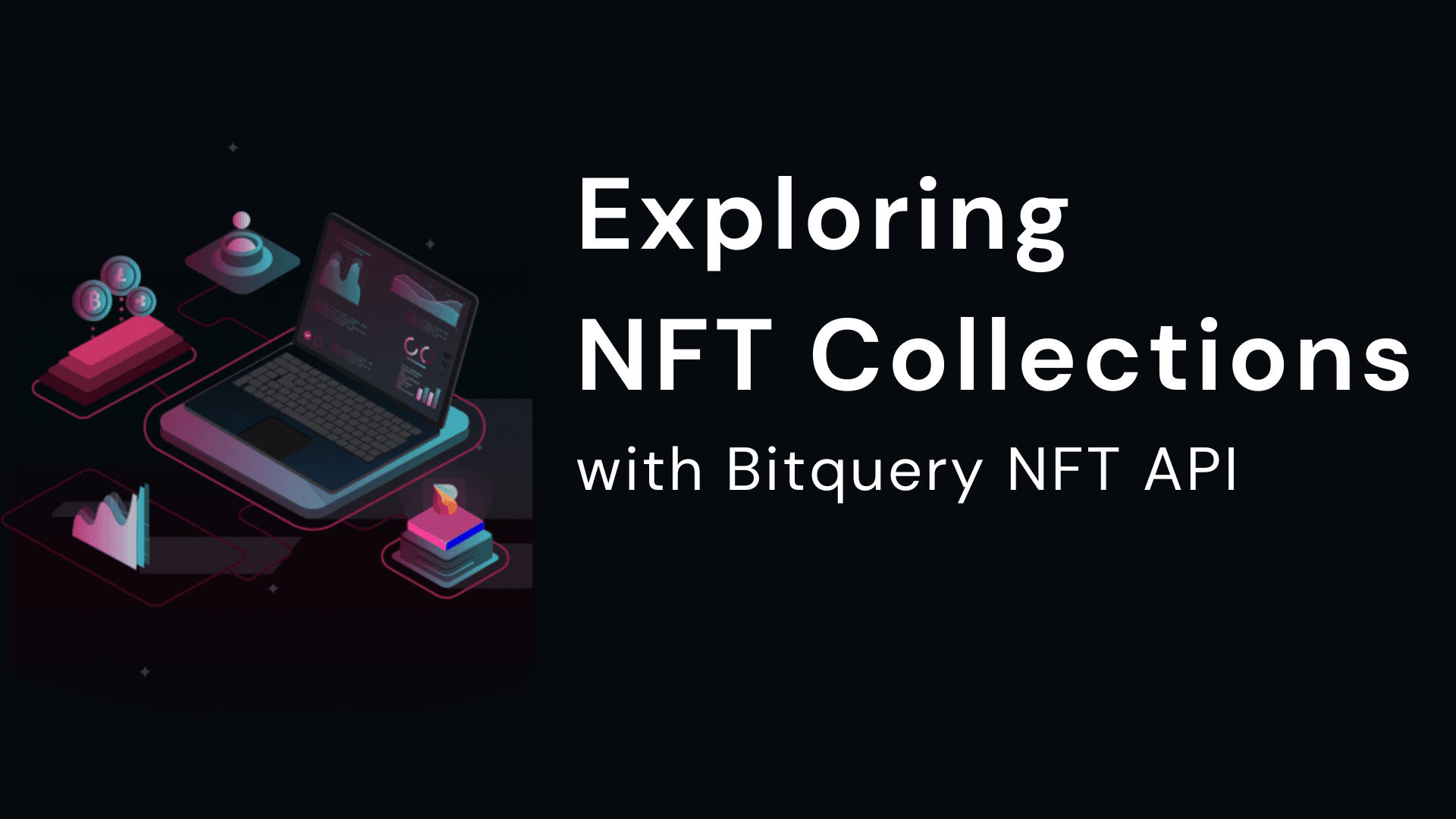
Explore NFT Collections with Bitquery's API
In the ever-evolving digital landscape, buzzwords come and go, but few have captured the imagination and wallets of the masses like “NFTs”. From digital art masterpieces fetching millions to sports highlights turned into coveted digital collectibles, NFTs are reshaping the boundaries of ownership and value in the online realm. But what exactly are these digital assets? And how can one stay updated with the latest collections and their intricate details? Dive into the world of NFTs with us as we unravel their mysteries and explore how platforms like Bitquery are making it easier than ever to access real-time information on these unique tokens.
What is NFT?
NFTs, or Non-Fungible Tokens, are unique digital assets verified on a blockchain, distinct from interchangeable assets like bitcoin. Their distinctiveness is akin to trading cards; while bitcoins have equal value, trading cards can vary greatly in worth. The surge in NFT popularity has attracted artists, musicians, and sports leagues, transforming monetization of digital art, music, and game items. Their allure stems from their uniqueness and blockchain-backed proof of authenticity.
What is an NFT Collection?
An NFT collection comprises unique digital assets, often unified by a theme and crafted by artists or teams. These collections are primarily on NFT marketplaces like OpenSea and Rarible. NBA Top Shot's "NBA Moments" is a prominent example, converting basketball highlights into digital cards. Purchasing these NFTs typically involves cryptocurrencies like ether (ETH). The rise of NFTs has been swift and turbulent, with some fetching millions and igniting debates about value and digital ownership.
Why Use an NFT Collection API?
An NFT Collection API provides a centralized source of information, pulling together data from various NFT platforms, artists, and collections. This ensures that users have a holistic view of the NFT market at their fingertips. This includes:
- Real-time Updates: The NFT market is dynamic, with new collections and assets being added frequently. An API ensures that you receive real-time updates, allowing you to stay ahead of trends and make informed decisions.
- Integration Capabilities: For developers and platforms, an API offers seamless integration. Whether you’re building an NFT marketplace, a portfolio tracker, or a news platform, an API ensures that your platform is always populated with the latest data.
- Customized Data Retrieval: Not everyone needs all the data all the time. An NFT Collection API allows users to tailor their data requests, fetching only what’s relevant to them. This ensures efficiency and relevance in data retrieval.
- Market Analysis: For investors and collectors, understanding market trends is crucial. An API can provide historical data, allowing for trend analysis, price predictions, and understanding market movements.
- Cost-Efficient: Instead of building data retrieval systems from scratch or manually tracking NFT collections, an API provides a cost-effective solution, reducing the need for extensive resources and time investments.
NFTs are a global phenomenon. An NFT Collection API ensures that you have access to information from collections and marketplaces worldwide, breaking down regional barriers. For newcomers to the NFT space, this can serve as an educational tool, providing insights into popular collections, historical trends, and the overall landscape of the NFT market.
How to Access the Latest NFT Collections Information with Bitquery?
Bitquery stands out as a powerful tool for anyone diving deep into the NFT space. With its robust APIs, it offers a comprehensive view of NFT data across multiple blockchain networks. Whether you’re tracking historical trends or seeking real-time updates, Bitquery has got you covered. Key Features of Bitquery include:
- Different Angles of Data: Bitquery NFT API offers a range of functionalities that includes users to identify NFT holders for specific projects, view all NFTs linked to a particular address, and track the most recent trades for any given project.
Additionally, you can monitor all NFT transfers within a specific block and observe every transfer associated with a particular NFT. And that’s just scratching the surface; there’s so much more it can do.
-
User-Friendly Interface: For those new to Bitquery, the platform offers an intuitive IDE. Simply register, and you’re ready to create and run your first query.
-
Real-time Data Access: Bitquery’s GraphQL subscription ensures you have access to real-time blockchain data without any delay. Historical Data Analysis: Through Bitquery’s GraphQL APIs, users can delve into historical data, including token transfers, trades, NFTs, and even mempool data.
-
Cloud Data Sets: For those who prefer cloud platforms, Bitquery provides data access through popular cloud infrastructures like AWS S3, Microsoft Azure, Snowflake, and Google BigQuery.
Bitquery’s NFT Collection API is a powerful tool designed to provide insights into the world of NFTs. Let’s dive in and see how it works in real-time. Also, all the code that we’re executing is run through the Bitquery IDE.
- Discovering Trending NFT Collections
The Bitquery NFT collection API can be used to get trending NFT collections.
The following query is designed to retrieve the top 10 trending NFT collections on the Ethereum network:
query MyQuery {
EVM(dataset: combined, network: eth) {
DEXTrades(
orderBy: {descendingByField: "count"}
limit: {count: 10}
where: {Trade: {Buy: {Currency: {Fungible: false}}}, Block: {Date: {after: "2023-08-20"}}}
) {
count
sum(of: Trade_Sell_Amount)
Trade {
Buy {
Currency {
Name
SmartContract
}
}
}
}
}
}
The query focuses on non-fungible trades (NFTs) made after 20th August 2023 and orders them by the count of trades, giving us a snapshot of the most traded collections.
Output:
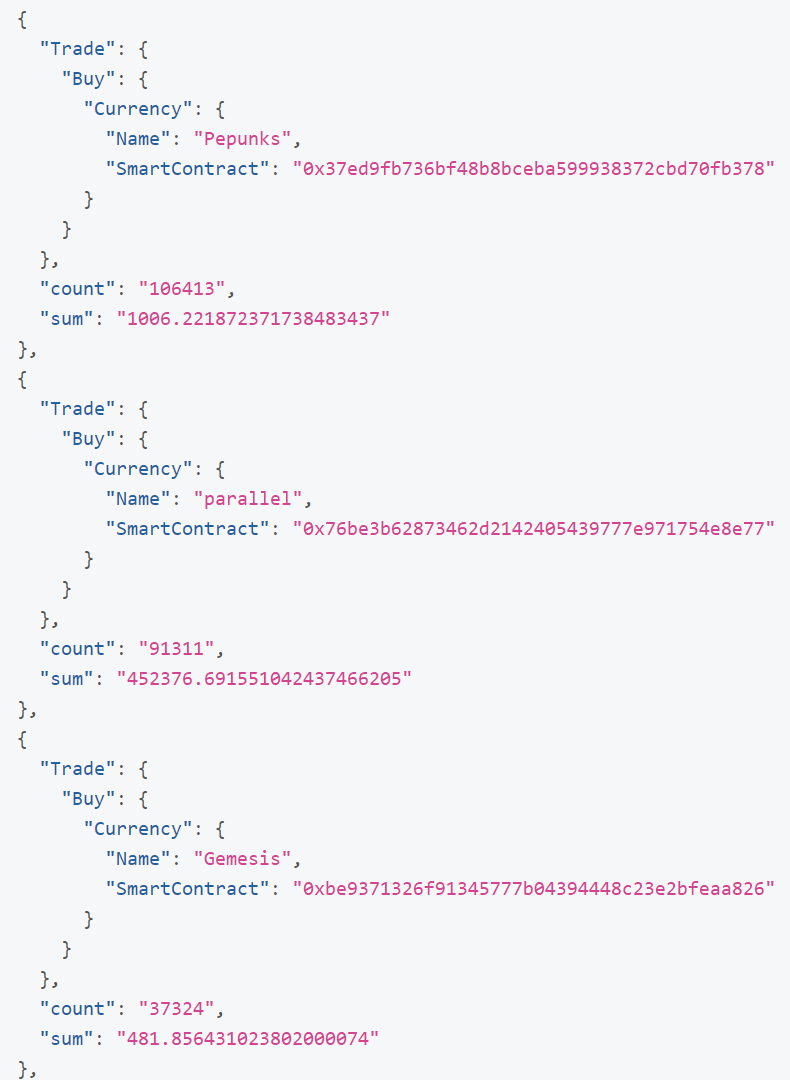
From the output, it’s clear that pepunks, genesis, parallel, and gemesis are leading the pack as the top 4 NFT collections in terms of sales after 20th August 2023. This information can be invaluable for those looking to understand market trends, make investment decisions, or simply stay updated on the NFT landscape.
If you’re eager to delve even deeper, the Bitquery explorer is a great place to start. For instance, if we want to analyze pepunks in more detail, the explorer offers a user-friendly and intuitive interface.
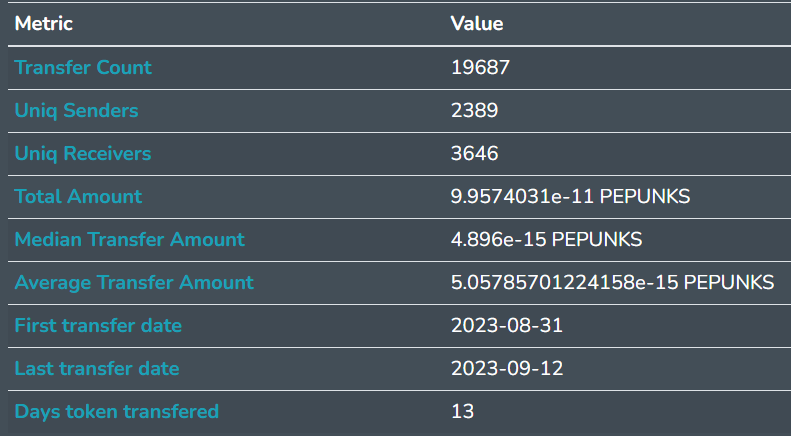
Additionally, it showcases popular Token IDs for NFTs based on transfer count. But remember, this is just scratching the surface. There’s a whole lot more waiting to be discovered.

- Dive Deep into NFT Metadata with Bitquery
Bitquery’s NFT collection API isn’t just about tracking transfers or trades; it’s a comprehensive tool that allows users to access the complete metadata of NFTs. This includes information such as the NFT’s name, description, and image.
{
EVM(dataset: combined, network: eth) {
Transfers(
where: {Transfer: {Currency: {SmartContract: {in: ["0x572E33FFa523865791aB1C26B42a86aC244Df784", "0x68F4Ba8018216542Ac2Ab8125166Be66304DD71c", "0x28472a58A490c5e09A238847F66A68a47cC76f0f", "0x8b8D1225bB21CA07812FF3c2ee9358f7b5d90EcA", "0xb92b8d7e45c0f197A8236c8345b86765250BAF7c"]}}}}
limitBy: {by: Transfer_Currency_SmartContract, count: 1}
) {
Transfer {
Currency {
SmartContract
Name
Decimals
Fungible
HasURI
Symbol
}
Id
URI
Data
owner: Receiver
}
}
}
}
Output:
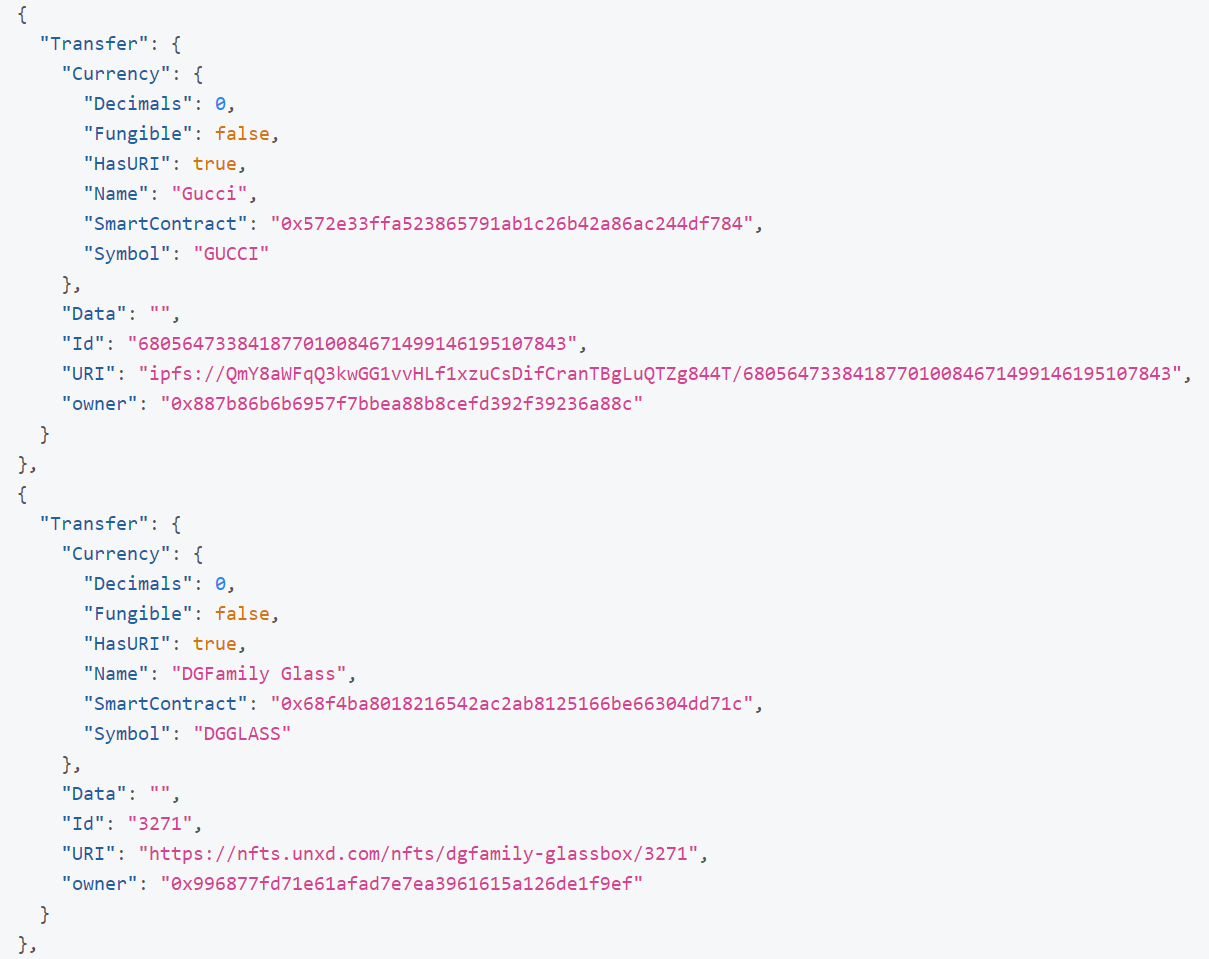
From the output, it’s evident how detailed the metadata can be. It provides a clear picture of the NFT’s attributes, making it easier for users, collectors, or developers to understand the details of the above NFTs.
When we navigate to the Bitquery Explorer, it offers a deeper dive into the details of the mentioned NFTs. Taking the 1st Gucci NFT as an example, the platform provides insights like the ‘Top NFT Holders’, giving us a clearer picture of its distribution and ownership patterns.
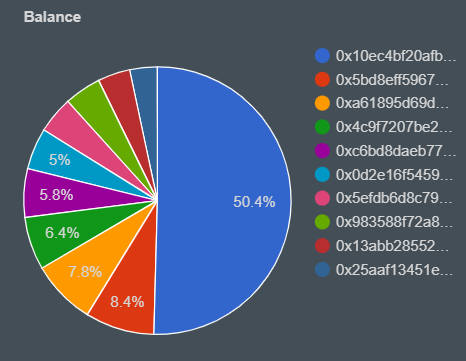
- Identifying Current Owners of a Specific NFT Collection
One of the powerful features of the Bitquery NFT collection API is its ability to provide a comprehensive list of current token holders for a specific NFT collection. This is particularly useful for understanding the distribution and ownership dynamics of a particular set of NFTs.
{
EVM(dataset: archive, network: eth) {
BalanceUpdates(
where: {Currency: {SmartContract: {is: "0x23581767a106ae21c074b2276d25e5c3e136a68b"}}}
limitBy: {by: BalanceUpdate_Address, count: 1}
limit: {count: 1000}
orderBy: {descendingByField: "sum"}
) {
sum(of: BalanceUpdate_Amount, selectWhere: {gt: "0"})
BalanceUpdate {
Address
}
}
}
}
Output:
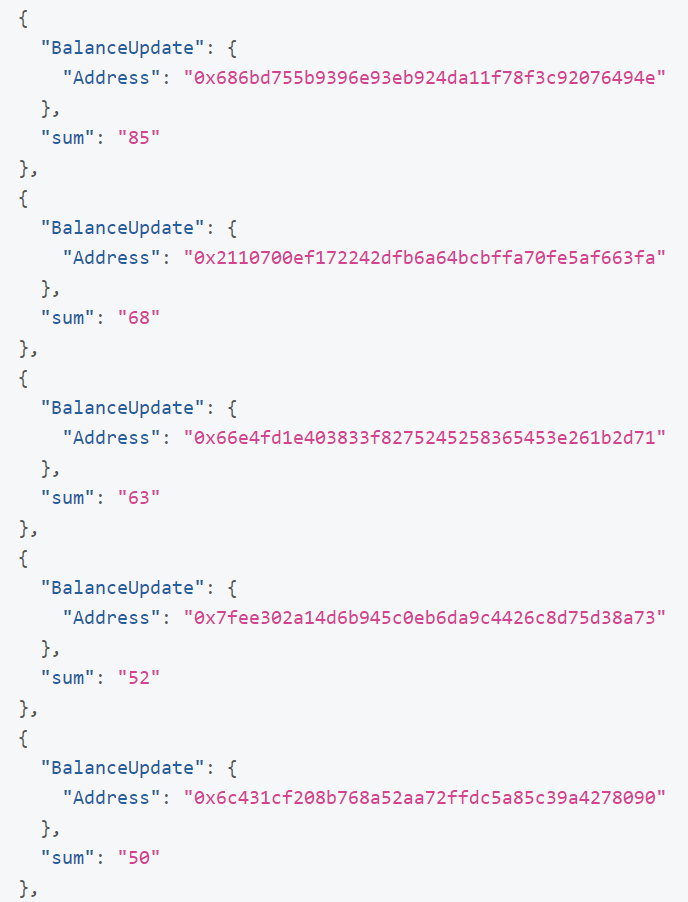
From the output, it becomes evident which addresses currently hold tokens from the specified NFT collection. This data can be invaluable for artists, collectors, and market analysts aiming to understand the current distribution of a particular NFT set.
If a you're just getting started with Bitquery, they should begin with this intro video. For those keen on diving deeper into NFT APIs, a detailed NFT Tutorial is the way to go. Bitquery also offers a range of helpful tutorials and guides for anyone wanting to learn more about NFTs. Some of the top picks include:
- Best NFT Market Trackers
- Bitquery NFT Marketplace APIs: How to get NFT Data
- BLUR NFT Marketplace API
- Top NFT Data Sources
- How to Track NFT Wash Trading?
- Opensea NFT API - A Complete Developer Guide
Bitquery has a very active and responsive support system. Whether you have a quick question or encounter a bug, there’s a channel for you. Connect with Bitquery on Telegram, Discord, and the Community Forum.
Conclusion
NFTs have revolutionized the way we think about digital ownership and authenticity. These unique tokens, backed by the immutable nature of blockchain technology, have not only provided artists and creators with new avenues for monetization but have also offered collectors a fresh perspective on digital assets. With platforms like Bitquery, accessing and utilizing data about NFT collections has never been easier. Whether you’re a developer looking to integrate NFT data into your application or an enthusiast wanting to stay updated on the latest collections, Bitquery’s NFT Collection API is a powerful tool to have in your arsenal. With Bitquery, keeping up with the ever-changing world of NFTs becomes much easier.
Post written by guest author Yash
Subscribe to our newsletter
Subscribe and never miss any updates related to our APIs, new developments & latest news etc. Our newsletter is sent once a week on Monday.


